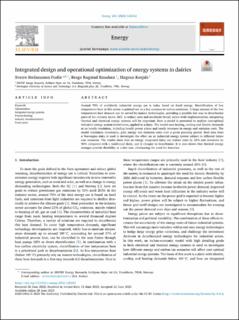| dc.contributor.author | Foslie, Sverre Stefanussen | |
| dc.contributor.author | Knudsen, Brage Rugstad | |
| dc.contributor.author | Korpås, Magnus | |
| dc.date.accessioned | 2023-12-12T09:57:09Z | |
| dc.date.available | 2023-12-12T09:57:09Z | |
| dc.date.created | 2023-08-24T13:49:04Z | |
| dc.date.issued | 2023 | |
| dc.identifier.citation | Energy. 2023, 281 . | en_US |
| dc.identifier.issn | 0360-5442 | |
| dc.identifier.uri | https://hdl.handle.net/11250/3107042 | |
| dc.description.abstract | Around 70% of worldwide industrial energy use is today based on fossil energy. Electrification of low temperature heat in this sector is pointed out as a key measure to reduce emissions. A large amount of the low temperature heat demand can be served by mature technologies, providing a possible fast way to decarbonize parts of the industry sector. Still, to reduce costs and accelerate broad, sector-wide implementation, integrating thermal and electrical energy systems will be important. Here a model is presented to analyse cost-optimal industrial energy system investments, applied to a dairy. The model uses heating, cooling and electric demands at an hourly resolution, including hourly power prices and yearly increases in energy and emission costs. The model minimizes investment, grid, energy and emission costs over a given planning period. Real data from a Norwegian dairy is used to investigate the effect on an industrial energy system subject to different future cost scenarios. The results show that an energy integrated dairy can reduce costs by 24% and emissions by 96% compared with a traditional dairy, and is cheaper to decarbonize. It is also shown that thermal energy storages provide flexibility at a low cost, eliminating the need for batteries. | en_US |
| dc.language.iso | eng | en_US |
| dc.publisher | Elsevier | en_US |
| dc.rights | Navngivelse 4.0 Internasjonal | * |
| dc.rights.uri | http://creativecommons.org/licenses/by/4.0/deed.no | * |
| dc.title | Integrated design and operational optimization of energy systems in dairies | en_US |
| dc.title.alternative | Integrated design and operational optimization of energy systems in dairies | en_US |
| dc.type | Peer reviewed | en_US |
| dc.type | Journal article | en_US |
| dc.description.version | publishedVersion | en_US |
| dc.rights.holder | The Authors | en_US |
| dc.source.pagenumber | 0 | en_US |
| dc.source.volume | 281 | en_US |
| dc.source.journal | Energy | en_US |
| dc.identifier.doi | 10.1016/j.energy.2023.128242 | |
| dc.identifier.cristin | 2169385 | |
| dc.relation.project | Norges forskningsråd: 257626 | en_US |
| dc.relation.project | Norges forskningsråd: 257632 | en_US |
| dc.relation.project | Norges forskningsråd: 323330 | en_US |
| dc.source.articlenumber | 128242 | en_US |
| cristin.ispublished | true | |
| cristin.fulltext | original | |
| cristin.qualitycode | 2 | |

